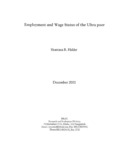| dc.contributor.author | Halder, Shantana R. | |
| dc.date.accessioned | 2019-08-29T05:54:00Z | |
| dc.date.available | 2019-08-29T05:54:00Z | |
| dc.date.issued | 2000-12 | |
| dc.identifier.citation | Halder, S. R. (2000). Employment and wage status of the ultra poor. Research Reports (2000), Economic Studies, (XVI), 61–30. | en_US |
| dc.identifier.uri | http://hdl.handle.net/10361/12507 | |
| dc.description.abstract | This report looked into the employment status of the ultra poor and factors affecting
the extent of employment. Findings showed that 92% of the households were with
economically active population. Majority of the rest 8% were female-headed
households mostly depending on others' help. Sixty-six percent of the economically
active population participated in the labour force. The prevalence of child labour was
12.7% and 2.5% respectively among boys and girls aged 6-14 years. For the ultra poor
lacking education and skills, one of the ways of increasing their household income was
an addition of household members in the active labour force. This was true for the
household having such potentiality. For households without physically acuve
members it could not be the option. Secondly, although an addition in the amve
labour force was one of the alternatives to increase income the rate of return from such
addition was not same for males and females. The income labour ratio for male was
higher than female. The existing gender division of labour, discriminative wage
variations disfavouring females, limited female employment opportunities were the
major reasons behind this. Thirdly, due to significant variations in the extent of
employment in different region any development programme would not be equally
beneficial for all regions. | en_US |
| dc.language.iso | en | en_US |
| dc.publisher | Research and Evaluation Division, Brac | en_US |
| dc.subject | Ultra poor | en_US |
| dc.subject | Employment | en_US |
| dc.subject.lcsh | Wages | |
| dc.title | Employment and wage status of the ultra poor | en_US |
| dc.type | Research report | en_US |

